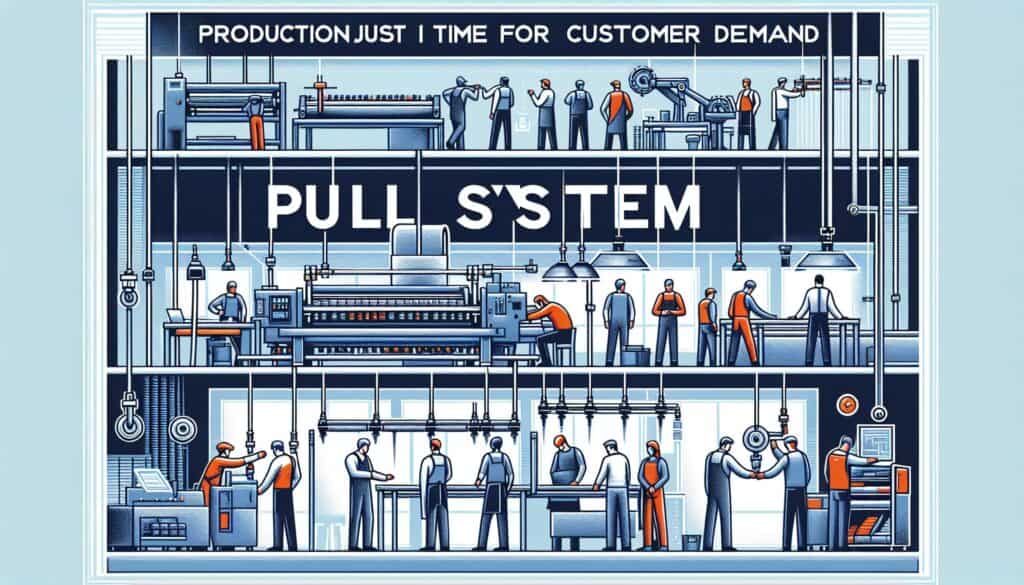Producir artículos sólo cuando los necesite la siguiente fase del proceso o el cliente, minimizando la sobreproducción y las existencias.
- Metodologías: Ingeniería, Ergonomía
Sistema pull

Sistema pull
- Mejora continua, Justo a tiempo (JIT), Kanban, Manufactura esbelta, Mejora de procesos, Eficacia de la producción, Cadena de suministro, Mapeo del flujo de valor, Estrategias de eliminación de residuos
Objetivo:
Cómo se utiliza:
- A Lean manufacturing principle where downstream activities signal their needs to upstream activities. Work is "pulled" through the system based on actual demand, often using tools like Kanban cards.
Ventajas
- Reduce los residuos (especialmente el exceso de producción y las existencias); mejora la eficacia de los flujos y la capacidad de respuesta; reduce los costes de almacenamiento; aumenta la satisfacción del cliente gracias a la puntualidad de las entregas.
Contras
- Requiere proveedores fiables y una demanda estable para un rendimiento óptimo; Puede ser difícil de aplicar en cadenas de suministro complejas o con una demanda muy variable; Requiere una ejecución y una comunicación disciplinadas.
Categorías:
- Lean Sigma, Fabricación
Ideal para:
- Controlar el flujo de recursos en un proceso de producción reponiendo sólo lo que se ha consumido, en función de la demanda real de los clientes.
The Pull System methodology is prominently utilized in various industries such as automotive, electronics, and consumer goods, where customer demands fluctuate and need accurate synchronization with production processes. This approach is particularly effective during the production phase where ongoing assessment of consumer need dictates the pace of manufacturing, thereby facilitating a more agile response to market changes. Participants in this methodology typically include cross-functional teams that engage in transparent communication, allowing for real-time data sharing and decision-making based on actual consumption rather than forecasts. For example, in the automotive industry, manufacturers often employ Kanban boards to visualize workflow and inventory status, ensuring that components are replenished as they are used, thereby minimizing excess stock and associated carrying costs. By encouraging workers on the assembly line to signal when parts are needed, organizations can ensure that they are only producing what is required by the next step in the process. This not only enhances operational efficiency but also contributes to a culture of continuous improvement where feedback loops inform adjustments in production strategy. Tools such as value stream mapping often accompany the Pull System to identify and eliminate waste, fostering an environment of continuous refinement. Such methodologies have been integral in enhancing customer satisfaction by optimizing lead times and increasing product availability without the burden of overproduction.
Pasos clave de esta metodología
- Identify the final product and its requirements from customer feedback.
- Map the value stream to visualize processes and identify wasteful practices.
- Define pull signals, such as Kanban cards, to indicate when to produce or move items.
- Implement systems to react to pull signals, adjusting production based on demand.
- Establish limits for work in progress (WIP) to enhance flow control and efficiency.
- Continuously review and refine processes to align with actual customer needs.
- Train all team members on the pull system principles and their applications.
- Encourage proactive communication and feedback between upstream and downstream processes.
Consejos profesionales
- Implement robust visual management techniques to enhance visibility of work in progress and real-time status updates for improved decision-making.
- Regularly analyze lead times and cycle times to identify bottlenecks and continually refine the pull system for optimal performance.
- Encourage cross-functional collaboration to ensure alignment between production and demand signals, enhancing responsiveness and agility.
Leer y comparar varias metodologías, recomendamos el
> Amplio repositorio de metodologías <
junto con otras más de 400 metodologías.
Sus comentarios sobre esta metodología o información adicional son bienvenidos en la dirección sección de comentarios ↓ , así como cualquier idea o enlace relacionado con la ingeniería.
Contexto histórico
1930
1940
1950
1950
1958
1960
1960
1930
1940
1949
1950
1950
1960
1960
1960
(si se desconoce la fecha o no es relevante, por ejemplo "mecánica de fluidos", se ofrece una estimación redondeada de su notable aparición)















Publicaciones relacionadas
Cuestionarios sobre molestias musculoesqueléticas
Pruebas multivariantes (MVT)
Análisis de regresión múltiple
Sistemas de captura de movimiento
Método MoSCoW
Prueba de la mediana de Mood